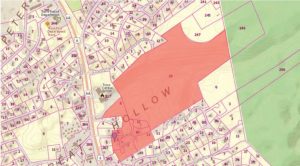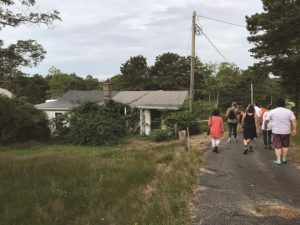TRURO — July 19 was a day of firsts for the members of the Walsh Property Community Planning Committee. That morning, they met each other in person for the first time. Then, on a site tour, they got their first glimpses of the 69.9-acre property whose fate they will decide.
The 16-member committee that took a year for the town — with help from a consultant — to assemble is tasked with determining what Truro will do with the plot of land behind Truro Central School, purchased by the town for $5.1 million in 2019 for “municipal purposes.”
Reflecting on the tour at a virtual committee meeting that evening, members praised the natural beauty of the land. They also debated what to do with the six ramshackle houses — part of an abandoned cottage colony — that occupy a small portion of the property near its southern boundary.

“My aspiration was for people to see the property together,” said Stacie Smith, managing director of the Consensus Building Institute. She is the consultant who was hired by the town in November 2019 to help select the committee members. Selection was completed nearly a year later in October 2020.
Choosing group members meant including a “balanced and broad range of perspectives, preferences, and demographics,” Smith previously told the Independent. Smith reviewed 30 applications, and the deadline for applications was extended by then-Town Manager Rae Ann Palmer in hopes more young people could be recruited.
“I don’t think it’s moving at the pace anyone would have liked,” chair of the Truro Housing Authority Kevin Grunwald, who was originally selected to serve on the committee but resigned in June for personal reasons, told the Independent earlier this month.
The committee is still not technically complete. The group is currently looking to recruit a high school student to be its 17th member. (A Truro bylaw requires all committees to have an odd number of members.)
At the meeting spot in the Truro Central School parking lot, committee members piled into a 12-seat electric bus owned by the town (a few who could not fit took cars). Jarrod Cabral, director of the Truro Dept. of Public Works, drove the group to Walsh Way, a road off Route 6 that leads to the cottages on the property.
As the group walked along a cracked asphalt path, Cabral explained the state of the six houses. A report on the houses done by Michele Cudilo, a consulting structural engineer, found that all six have deteriorated foundations. Any rehabilitation would need to include their replacement, which, according to the report, “requires lifting the structure(s) and excavation below the footprint.” The report goes on to say that “demolition and reconstruction is suggested.”
The six structures were built between 1900 and 1940, according to the assessor’s database, from kits sold by Sears, Roebuck and Co. Aside from needing foundations, all six have leaky roofs and mold, the report says.
Though the committee members were not allowed to enter the houses, the condition of the buildings was clear from their exteriors. Vines meander through the windows and gutters; shutters are falling off.

The group walked past a garage known to have asbestos present. Its door had been taped with a sign that read “DANGER.” Cabral told the committee members that several of the structures likely contain asbestos, based on when they were built, although the town has not done a definitive assessment of that issue.
After viewing all the cottages, the group left the Walsh Way site and drove to Leeward Passage, a street that leads to the north end of the property. In that area, the property is entirely wooded.
A trail wound through a bright forest of low oak and pine trees. Wintergreen and blueberry bushes filled the underbrush on either side of the path.
“We travel to a park in Vermont just to walk a trail like this,” said a committee member from the back of the line.
No deliberation was allowed during the site visit, so the members were not allowed to say much about what they were thinking. But at the virtual meeting of the entire committee that night, the buildings were the group’s focus. Multiple members said they were interested in how costly it would be to repair the buildings, rather than destroy them.
“They are so adorable,” said Morgan Clark, referring to the cottages. “I hope there’s some way we can restore them, if it’s feasible.”
Todd Schwebel, a carpenter on the committee, said that he estimated lifting a house and installing a new foundation would cost $60,000 to $70,000 per house, based on a similar project he had done. “There’s absolutely no way it would be economical to save those buildings, in my opinion,” he said.
A cost assessment was suggested. “I think that is an important step to take next,” said committee member Susan Howe.
Town Planner Barbara Carboni said she would “make clear it’s something the committee is very interested in” to Town Manager Darrin Tangeman.
The committee is currently looking into how to elicit community feedback, potentially through a survey. Though the actual survey design was not discussed, Assistant Town Manager Kelly Clark presented a technology for administering one — a platform called Bang the Table.



